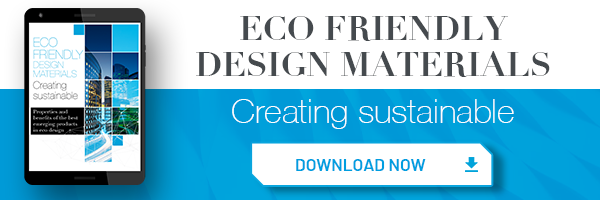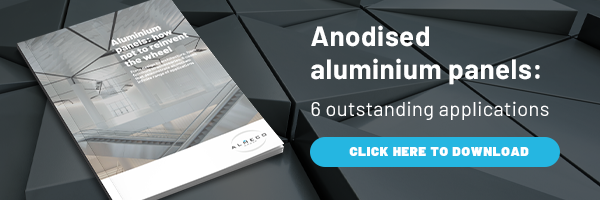Highly resistant but extremely ductile, aluminium is the material of choice for many designers who want to create unique decorative pieces in a wide range of applications, from façades cladding ti jewlery, point of sales, and even packaging.
These variaty is enable by different manufacturing processes, that allow to enanche aluminium’s qualities. Anodisation – an electrochemical oxidation process in which a protective layer of oxide forms on the surface of the metal to be treated – improves aluminium’s resistance to corrosion, as well as enables a wide range of finishes and colours.
Types of aluminium finishes
Anodised aluminum offers many possibilities for surface finishing: brushed, satin, mirror, and different textures. The wide range of anodised aluminum surfaces allows designers to use this material in an infinite number of projects. The advantages of using aluminium for architectural and interior design projects are many. Some finishes feature a particularly efficient reflectance: when used in ceilings, these aluminium surfaces optimise both natural and artificial light, improving the quality of living and working spaces.
1. Brushed or mirror aluminium finishes for perfectly even surfaces
A highly appreciated aluminium finish for architecture, interior design, and furniture is a brushed surface. Its appearance, thanks to a controlled rolling groove, becomes uniform and homogeneous, and touch-sensitive; high-gloss surface, on the other hand, makes the aluminium mirror like, perfectly reflective for impressive designs. The desired surface roughness (brushed or mirror) that is carried out during the milling process offers the advantage of creating smooth and homogeneous surfaces with very consistent quality.
2. Satin aluminium finishes: a tactile feeling
Unlike brushed and mirror surfaces, satin finishing requires a controlled chemical process, the etching. The satin surface becomes perfectly smooth and attractive: colour remains constant over the entire area, as does the appearance. In addition, the satin surface is soft and extraordinarily velvety, which is why satin-finished surfaces are generally used for objects where tactility is essential or when high diffusiveness is required
3. Textured aluminium: surface textures for special effects
Aluminium can achieve fascinating effects with textures. Typically, textures can be machined, creating interesting effects on surfaces; among the best known are the hammered and stucco effect, to name but one example. The textures effects can be achieved with simple mechanical processing and create unique perceptions when observed. A texture, for example, can make a tactile perception simply by looking at it without even needing to touch it. Special textured surfaces such as alluminium texture help to create a strong visual identity in architectural projects with a strong personality. An aluminium texture creates surfaces that change with the light, intensity, orientation, and viewing angle. Thanks to the textures, surfaces become alive and vibrant.
4. Aluminium finishes: a wide variety of colours without paints or lacquers
The options for the finishings are therefore many and varied. Whether smooth, textured and satin, the various surface finishes are completed by anodising, a treatment with many advantages. As well as making aluminium highly resistant to corrosion, anodising allows the coloured pigments to be incorporated into the anodic layer, resulting in a perfectly uniform and homogeneous surface across the entire surface width. Thanks to these treatments, anodised aluminium can reproduce many natural colors and the appearance of many metals, from titanium to steel, from brass to copper, from tin to bronze, from silver to gold, depending on the choice of tones, resulting in over 50 different colours and effects. And with the advantage of having no VOCs (volatile organic compounds), no formaldehyde, no varnish, no lacquer. The benefits of using anodised aluminium instead of other metals such as steel or copper are not only in the absence of VOCs. In fact, aluminium weighs 30% less than steel or copper, for example, making it a metal that is easier to transport and handle. In addition, aluminium can use laser technology to produce panels of any shape and design, saving costs and allowing greater flexibility in production.
Do you want to find out more about other outstanding applications of anodised aluminium suh as an aluminium panel? Download the White paper now >>>


